Avi Caciularu
MDCure: A Scalable Pipeline for Multi-Document Instruction-Following
Oct 30, 2024



Abstract:Multi-document (MD) processing is crucial for LLMs to handle real-world tasks such as summarization and question-answering across large sets of documents. While LLMs have improved at processing long inputs, MD contexts still present challenges, such as managing inter-document dependencies, redundancy, and incoherent structures. We introduce MDCure, a scalable and effective fine-tuning pipeline to enhance the MD capabilities of LLMs without the computational cost of pre-training or reliance on human annotated data. MDCure is based on generation of high-quality synthetic MD instruction data from sets of related articles via targeted prompts. We further introduce MDCureRM, a multi-objective reward model which filters generated data based on their training utility for MD settings. With MDCure, we fine-tune a variety of LLMs, from the FlanT5, Qwen2, and LLAMA3.1 model families, up to 70B parameters in size. Extensive evaluations on a wide range of MD and long-context benchmarks spanning various tasks show MDCure consistently improves performance over pre-trained baselines and over corresponding base models by up to 75.5%. Our code, datasets, and models are available at https://github.com/yale-nlp/MDCure.
CoverBench: A Challenging Benchmark for Complex Claim Verification
Aug 06, 2024Abstract:There is a growing line of research on verifying the correctness of language models' outputs. At the same time, LMs are being used to tackle complex queries that require reasoning. We introduce CoverBench, a challenging benchmark focused on verifying LM outputs in complex reasoning settings. Datasets that can be used for this purpose are often designed for other complex reasoning tasks (e.g., QA) targeting specific use-cases (e.g., financial tables), requiring transformations, negative sampling and selection of hard examples to collect such a benchmark. CoverBench provides a diversified evaluation for complex claim verification in a variety of domains, types of reasoning, relatively long inputs, and a variety of standardizations, such as multiple representations for tables where available, and a consistent schema. We manually vet the data for quality to ensure low levels of label noise. Finally, we report a variety of competitive baseline results to show CoverBench is challenging and has very significant headroom. The data is available at https://huggingface.co/datasets/google/coverbench .
SEAM: A Stochastic Benchmark for Multi-Document Tasks
Jun 23, 2024



Abstract:Various tasks, such as summarization, multi-hop question answering, or coreference resolution, are naturally phrased over collections of real-world documents. Such tasks present a unique set of challenges, revolving around the lack of coherent narrative structure across documents, which often leads to contradiction, omission, or repetition of information. Despite their real-world application and challenging properties, there is currently no benchmark which specifically measures the abilities of large language models (LLMs) on multi-document tasks. To bridge this gap, we present SEAM (a Stochastic Evaluation Approach for Multi-document tasks), a conglomerate benchmark over a diverse set of multi-document datasets, setting conventional evaluation criteria, input-output formats, and evaluation protocols. In particular, SEAM addresses the sensitivity of LLMs to minor prompt variations through repeated evaluations, where in each evaluation we sample uniformly at random the values of arbitrary factors (e.g., the order of documents). We evaluate different LLMs on SEAM finding that multi-document tasks pose a significant challenge for LLMs, even for state-of-the-art models with 70B parameters. In addition, we show that the stochastic approach uncovers underlying statistical trends which cannot be observed in a static benchmark. We hope that SEAM will spur progress via consistent and meaningful evaluation of multi-document tasks.
Identifying User Goals from UI Trajectories
Jun 20, 2024Abstract:Autonomous agents that interact with graphical user interfaces (GUIs) hold significant potential for enhancing user experiences. To further improve these experiences, agents need to be personalized and proactive. By effectively comprehending user intentions through their actions and interactions with GUIs, agents will be better positioned to achieve these goals. This paper introduces the task of goal identification from observed UI trajectories, aiming to infer the user's intended task based on their GUI interactions. We propose a novel evaluation metric to assess whether two task descriptions are paraphrases within a specific UI environment. By Leveraging the inverse relation with the UI automation task, we utilized the Android-In-The-Wild and Mind2Web datasets for our experiments. Using our metric and these datasets, we conducted several experiments comparing the performance of humans and state-of-the-art models, specifically GPT-4 and Gemini-1.5 Pro. Our results show that Gemini performs better than GPT but still underperforms compared to humans, indicating significant room for improvement.
Can Few-shot Work in Long-Context? Recycling the Context to Generate Demonstrations
Jun 19, 2024Abstract:Despite recent advancements in Large Language Models (LLMs), their performance on tasks involving long contexts remains sub-optimal. In-Context Learning (ICL) with few-shot examples may be an appealing solution to enhance LLM performance in this scenario; However, naively adding ICL examples with long context introduces challenges, including substantial token overhead added for each few-shot example and context mismatch between the demonstrations and the target query. In this work, we propose to automatically generate few-shot examples for long context QA tasks by recycling contexts. Specifically, given a long input context (1-3k tokens) and a query, we generate additional query-output pairs from the given context as few-shot examples, while introducing the context only once. This ensures that the demonstrations are leveraging the same context as the target query while only adding a small number of tokens to the prompt. We further enhance each demonstration by instructing the model to explicitly identify the relevant paragraphs before the answer, which improves performance while providing fine-grained attribution to the answer source. We apply our method on multiple LLMs and obtain substantial improvements on various QA datasets with long context, especially when the answer lies within the middle of the context. Surprisingly, despite introducing only single-hop ICL examples, LLMs also successfully generalize to multi-hop long-context QA using our approach.
TACT: Advancing Complex Aggregative Reasoning with Information Extraction Tools
Jun 05, 2024



Abstract:Large Language Models (LLMs) often do not perform well on queries that require the aggregation of information across texts. To better evaluate this setting and facilitate modeling efforts, we introduce TACT - Text And Calculations through Tables, a dataset crafted to evaluate LLMs' reasoning and computational abilities using complex instructions. TACT contains challenging instructions that demand stitching information scattered across one or more texts, and performing complex integration on this information to generate the answer. We construct this dataset by leveraging an existing dataset of texts and their associated tables. For each such tables, we formulate new queries, and gather their respective answers. We demonstrate that all contemporary LLMs perform poorly on this dataset, achieving an accuracy below 38\%. To pinpoint the difficulties and thoroughly dissect the problem, we analyze model performance across three components: table-generation, Pandas command-generation, and execution. Unexpectedly, we discover that each component presents substantial challenges for current LLMs. These insights lead us to propose a focused modeling framework, which we refer to as IE as a tool. Specifically, we propose to add "tools" for each of the above steps, and implement each such tool with few-shot prompting. This approach shows an improvement over existing prompting techniques, offering a promising direction for enhancing model capabilities in these tasks.
Unpacking Tokenization: Evaluating Text Compression and its Correlation with Model Performance
Mar 10, 2024Abstract:Despite it being the cornerstone of BPE, the most common tokenization algorithm, the importance of compression in the tokenization process is still unclear. In this paper, we argue for the theoretical importance of compression, that can be viewed as 0-gram language modeling where equal probability is assigned to all tokens. We also demonstrate the empirical importance of compression for downstream success of pre-trained language models. We control the compression ability of several BPE tokenizers by varying the amount of documents available during their training: from 1 million documents to a character-based tokenizer equivalent to no training data at all. We then pre-train English language models based on those tokenizers and fine-tune them over several tasks. We show that there is a correlation between tokenizers' compression and models' downstream performance, suggesting that compression is a reliable intrinsic indicator of tokenization quality. These correlations are more pronounced for generation tasks (over classification) or for smaller models (over large ones). We replicated a representative part of our experiments on Turkish and found similar results, confirming that our results hold for languages with typological characteristics dissimilar to English. We conclude that building better compressing tokenizers is a fruitful avenue for further research and for improving overall model performance.
Patchscopes: A Unifying Framework for Inspecting Hidden Representations of Language Models
Jan 12, 2024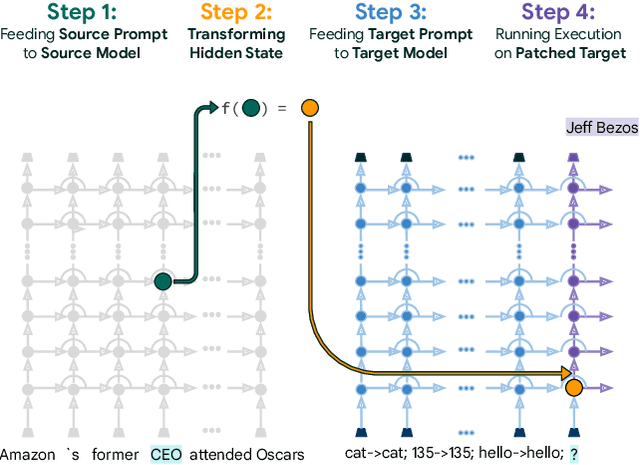
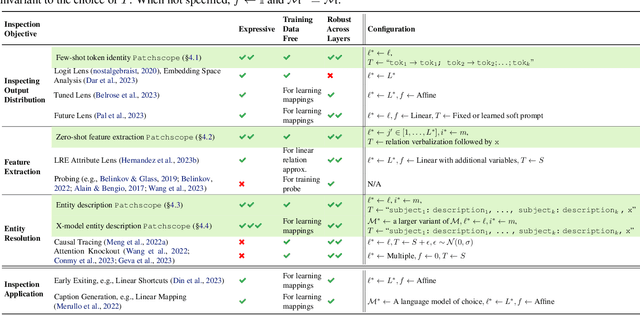
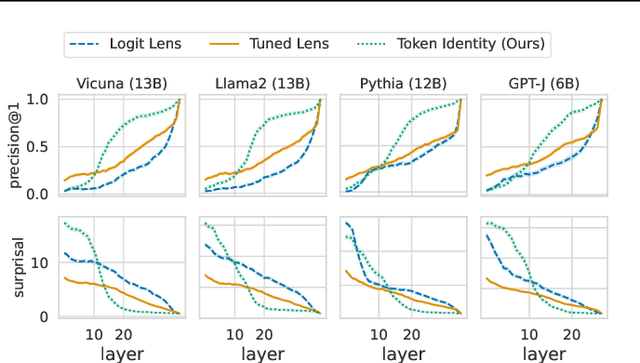
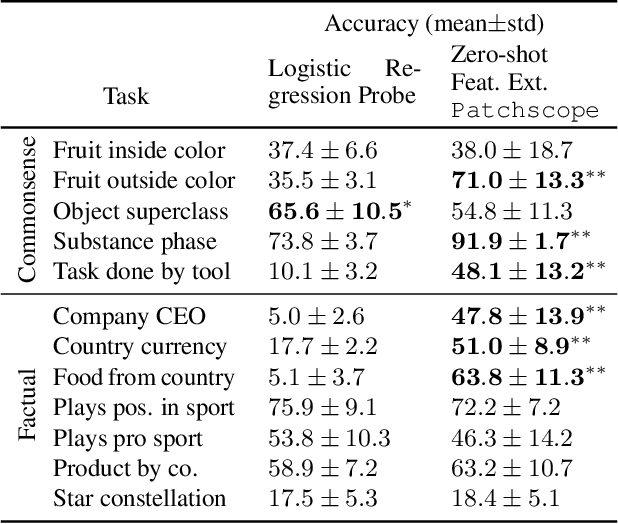
Abstract:Inspecting the information encoded in hidden representations of large language models (LLMs) can explain models' behavior and verify their alignment with human values. Given the capabilities of LLMs in generating human-understandable text, we propose leveraging the model itself to explain its internal representations in natural language. We introduce a framework called Patchscopes and show how it can be used to answer a wide range of questions about an LLM's computation. We show that prior interpretability methods based on projecting representations into the vocabulary space and intervening on the LLM computation can be viewed as instances of this framework. Moreover, several of their shortcomings such as failure in inspecting early layers or lack of expressivity can be mitigated by Patchscopes. Beyond unifying prior inspection techniques, Patchscopes also opens up new possibilities such as using a more capable model to explain the representations of a smaller model, and unlocks new applications such as self-correction in multi-hop reasoning.
Optimizing Retrieval-augmented Reader Models via Token Elimination
Oct 20, 2023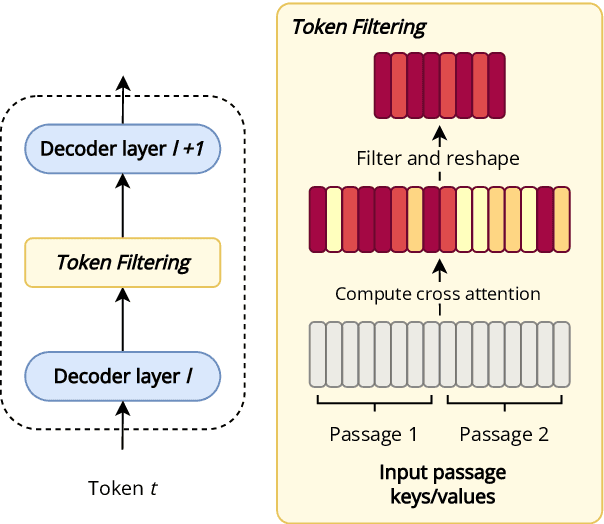
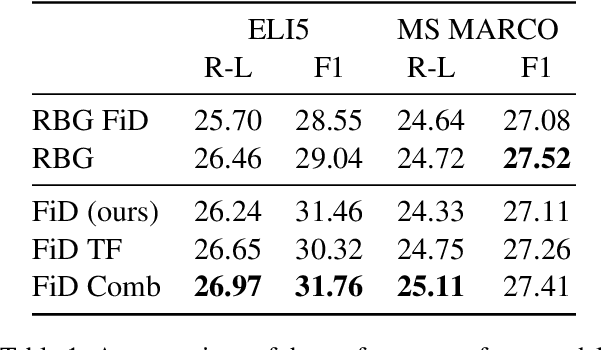
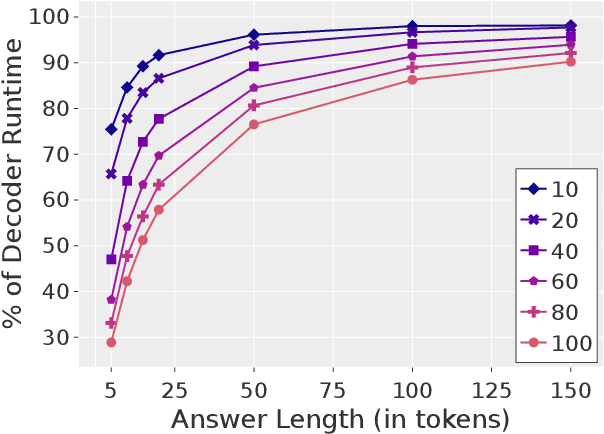
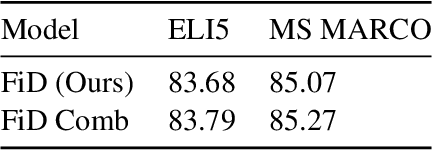
Abstract:Fusion-in-Decoder (FiD) is an effective retrieval-augmented language model applied across a variety of open-domain tasks, such as question answering, fact checking, etc. In FiD, supporting passages are first retrieved and then processed using a generative model (Reader), which can cause a significant bottleneck in decoding time, particularly with long outputs. In this work, we analyze the contribution and necessity of all the retrieved passages to the performance of reader models, and propose eliminating some of the retrieved information, at the token level, that might not contribute essential information to the answer generation process. We demonstrate that our method can reduce run-time by up to 62.2%, with only a 2% reduction in performance, and in some cases, even improve the performance results.
The Curious Case of Hallucinatory Unanswerablity: Finding Truths in the Hidden States of Over-Confident Large Language Models
Oct 18, 2023
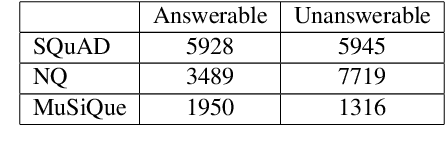

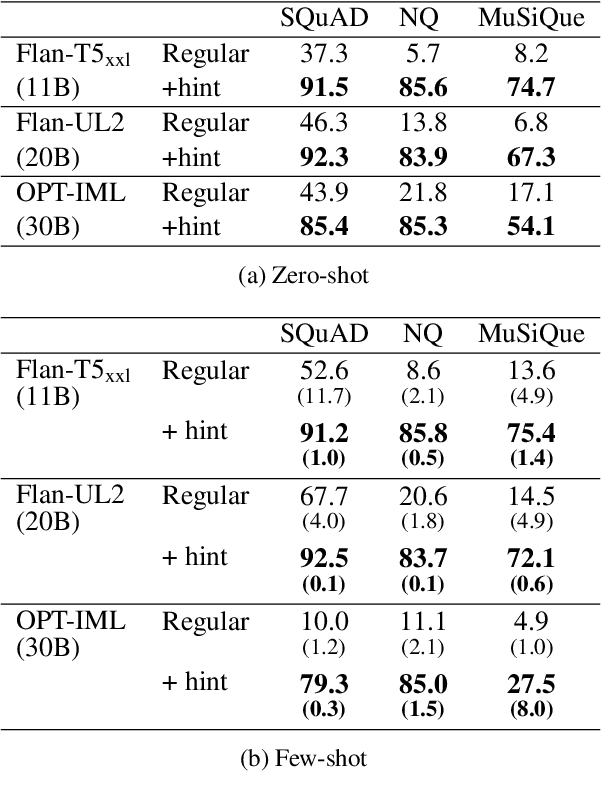
Abstract:Large language models (LLMs) have been shown to possess impressive capabilities, while also raising crucial concerns about the faithfulness of their responses. A primary issue arising in this context is the management of unanswerable queries by LLMs, which often results in hallucinatory behavior, due to overconfidence. In this paper, we explore the behavior of LLMs when presented with unanswerable queries. We ask: do models \textbf{represent} the fact that the question is unanswerable when generating a hallucinatory answer? Our results show strong indications that such models encode the answerability of an input query, with the representation of the first decoded token often being a strong indicator. These findings shed new light on the spatial organization within the latent representations of LLMs, unveiling previously unexplored facets of these models. Moreover, they pave the way for the development of improved decoding techniques with better adherence to factual generation, particularly in scenarios where query unanswerability is a concern.
 Add to Chrome
Add to Chrome Add to Firefox
Add to Firefox Add to Edge
Add to Edge